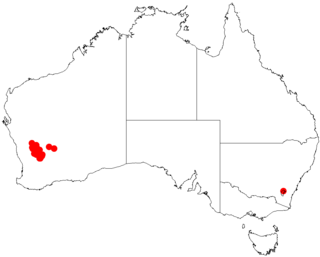
Acacia pulchella, commonly known as prickly moses or western prickly moses, is a shrub in the family Fabaceae. Endemic to Western Australia, it is one of the most common shrubs of the bushland around Perth and in the Darling Range.

Acacia conniana is a shrub belonging to the genus Acacia and the subgenus Juliflorae that is endemic to the southern coast of western Australia.
Acacia gibsonii, commonly known as Gibson's wattle, is a shrub belonging to the genus Acacia and the subgenus Juliflorae.
Acacia incongesta, also known as Peak Charles wattle, is a shrub belonging to the genus Acacia and the subgenus Juliflorae that is endemic to a small area in south western Australia

Acacia hastulata is a shrub belonging to the genus Acacia and the subgenus Phyllodineae that is endemic to an area in south western Australia.

Acacia maxwellii is a shrub belonging to the genus Acacia and the subgenus Phyllodineae that is endemic to south western Australia.

Acacia phlebopetala is a shrub belonging to the genus Acacia and the subgenus Phyllodineae that is endemic to south western Australia.

Acacia profusa is a shrub of the genus Acacia and the subgenus Phyllodineae that is endemic to south western Australia.

Acacia pusilla is a shrub of the genus Acacia and the subgenus Phyllodineae the is endemic to south western Australia.
Acacia rhamphophylla, commonly known as Kundip wattle, is a shrub of the genus Acacia and the subgenus Phyllodineae that is endemic to a small area in south western Australia. It is listed as an endangered species according to the Environment Protection and Biodiversity Conservation Act 1999.

Acacia bartlei, commonly known as Bartle's wattle, is a shrub or tree of the genus Acacia and the subgenus Plurinerves. It is native to a small area along the south coast in the Goldfields-Esperance region of Western Australia.

Acacia curvata is a shrub of the genus Acacia and the subgenus Plurinerves that is endemic to an area in south western Australia.

Acacia densiflora is a shrub of the genus Acacia and the subgenus Plurinerves that is endemic to an area of south western Australia.

Acacia lobulata, commonly known as Chiddarcooping wattle, is a shrub of the genus Acacia and the subgenus Plurinerves that is endemic to a small area of south western Australia. It was declared as rare flora in 1997 and is now listed a Endangered under the Environment Protection and Biodiversity Conservation Act 1999.

Acacia nitidula is a shrub of the genus Acacia and the subgenus Plurinerves that is endemic to an area along the south coast of south western Australia.

Acacia obtecta is a shrub of the genus Acacia and the subgenus Plurinerves that is endemic to a small area in south western Australia.

Acacia octonervia is a shrub of the genus Acacia and the subgenus Plurinerves that is endemic to a small area along the south western coast of Australia.

Acacia ophiolithica is a shrub of the genus Acacia and the subgenus Plurinerves where it is endemic to a small area along the south west coast of Australia.
Acacia papulosa is a shrub of the genus Acacia and the subgenus Plurinerves that is endemic to a small area along the south coast of south western Australia.

Acacia kalgoorliensis is a shrub of the genus Acacia and the subgenus Plurinerves that is endemic to an area of south western Australia.
















